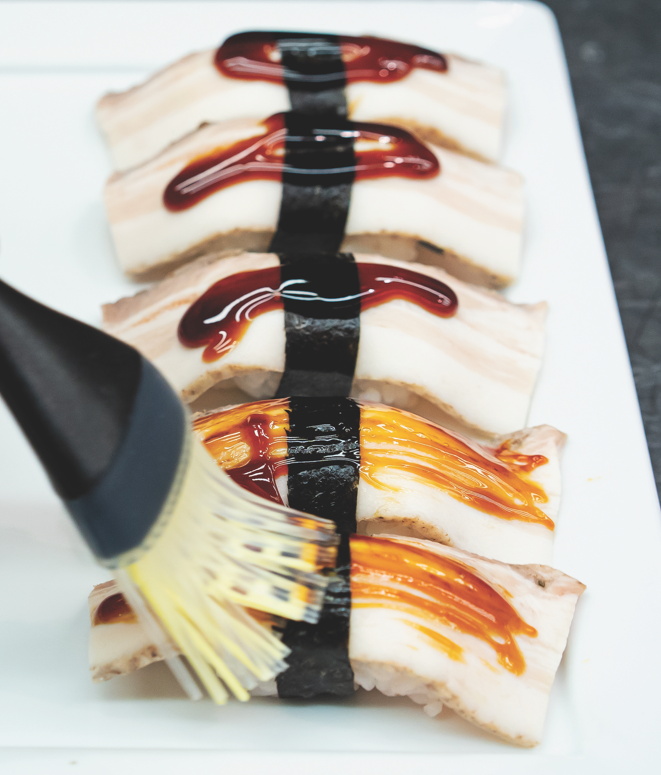By Morgan Fecto | Photography by Scott Suchman
Ever since sushi was introduced to the U.S. food scene in the 1960s, chefs have been reimagining Japanese nigiri, sashimi, and maki to suit American palates—from the California rolls of the ’70s to the tempura rolls with spicy mayo of today. And now comes the latest iteration in reinvented sushi: “Sous-shi.”
“Sous-shi uses sous vide products and cooking methods as an alternative to raw products,” says Cuisine Solutions chef Kyong Park. “With growing concerns about overfishing, high mercury levels, foreign bacteria or parasites, and increasing food costs, sous vide is a perfect alternative while still maintaining a sense of sushi.”
With sous vide-cooked ingredients that celebrate the umami-rich flavors and traditional presentations of Japanese sushi, sous-shi can be an exciting facsimile for those who want to avoid raw fish, or for others, as an entry point to sous vide cooking and sushi making. Before diving into our Pork Belly Unagi Style Nigiri Sous-shi and Tomato Confit Sous-shi recipes, consult these steps for trying sous-shi at home.
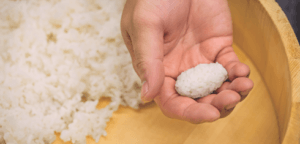
STEP ONE: RINSE YOUR RICE
Rice is the foundation for nigiri, a common sushi style that includes a base of rice topped with a slice of fish. Seasoned with vinegar and sugar, sushi rice is bright and tangy—but adding too much vinegar will make the rice too loose to shape. For rice that’s sticky but not pasty, soak overnight then rinse in a fine-mesh sieve until the water runs clear. Unlike basmati or jasmine rice, short-grain rice is starchier and needs thorough rinsing. It also makes the best sushi rice.
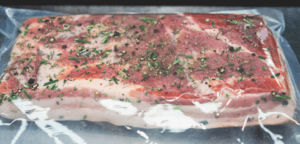
STEP TWO: START TO SOUS VIDE
It’s hard to confit delicate tomatoes with traditional poaching. That’s why our Tomato Confit Sous-shi involves cooking Roma tomatoes sous vide to ensure a consistent temperature that won’t break down the tomato. Sous vide also seals in the flavors of garlic and ginger and enhances the tomatoes’ ruby-red color to a shade that’s reminiscent of raw tuna. While sous vide lends the tomatoes a silky texture, it makes the pork belly used in our Pork Belly Unagi Style Nigiri Sous-shi buttery and tender. Try out different cuts for your sous-shi—sirloin also works great—but remember that sous vide seals in bad flavors, too. For the best taste, choose high-quality cuts that are fresh.
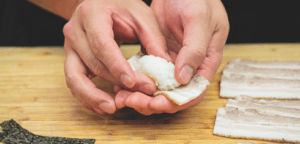
STEP THREE: A BALANCED ASSEMBLY
“Balance is key. You want to make sure the rice isn’t overbearing—about the same size as the pork belly,” chef Kyong Park says of the pork belly sous-shi. For sous-shi recipes, chilling the meat before you cut it and assemble your sous-shi is crucial. If the meat is still hot, it will be harder to slice evenly and it will leak juice all over your perfectly formed rice mounds. Take care when opening the sous vide pouch containing your confit tomatoes to avoid crushing them. And if you’re assembling lots of sous-shi, polyethylene gloves will keep the rice from sticking to your fingers.
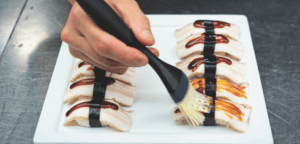
STEP FOUR: THE FINAL TOUCH
Give your sous-shi its final seasoning. A sweet, Unagi-style glaze with mirin and sake complements savory meat-based sous-shi rolls like pork belly. Pouring the tomato liquid reserved from the sous vide pouch over your tomato sous-shi kicks up the flavor. As with any sushi, soy sauce is a must for dipping. Try a light soy sauce for meat-based sous-shi, and invest in a bottle of Tamari for vegetable sous-shi. It’s gluten free with a deep miso taste.
Related RecipesVIEW ALL RECIPES
Pork Belly Unagi Sous-shi
 Intermediate
IntermediateCuisine Solutions chef Kyong Park developed “sous-shi” using sous vide proteins as an alternative to using raw ingredients.
Tomato Confit Sous-Shi
 Beginner
BeginnerInfused with savory garlic and soy sauce, tomatoes cooked sous vide top sushi rice in this elegant vegan recipe.
Related Articles VIEW ALL ARTICLES
Tips & Techniques
How to Sous Vide: Fish
Retain the vibrant color, texture, and juiciness of fish through the precise sous vide method.
Read More >Tips & Techniques
How to Sous Vide: Octopus
The sous vide method is the ultimate secret weapon for transforming octopus into an impossibly tender, delicate dish.
Read More >Tips & Techniques
How To: Cold-Brew Coffee with Sous Vide
Traditional cold-brew often calls for steeping overnight. Sous vide cuts that time down to mere hours.
Read More >